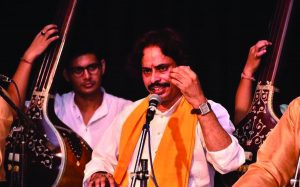 With the changing times, the name of Azamgarh district is just enough to haunt anybody because recently it has grabbed prime place in the crime map. Adjoining with the Bihar borders, the eastern Uttar Pradesh district has been in continuous surveillance of central and state security forces. This place has become infamous due to high profile extortion crimes of underworld and treated as nursery of powerful crime syndicate indulged in mafia activities. Nevertheless, it has another face too, which brings it on heritage map for preserving India’s traditional classical music, highly finished pottery and enticing textiles. Its ceramics may entice those who want to cook organic dishes in clay pots. The quality and purity of silk may launch hundreds of ideas for exclusively designed apparels.
With the changing times, the name of Azamgarh district is just enough to haunt anybody because recently it has grabbed prime place in the crime map. Adjoining with the Bihar borders, the eastern Uttar Pradesh district has been in continuous surveillance of central and state security forces. This place has become infamous due to high profile extortion crimes of underworld and treated as nursery of powerful crime syndicate indulged in mafia activities. Nevertheless, it has another face too, which brings it on heritage map for preserving India’s traditional classical music, highly finished pottery and enticing textiles. Its ceramics may entice those who want to cook organic dishes in clay pots. The quality and purity of silk may launch hundreds of ideas for exclusively designed apparels.
An NGO, Indian Trust for Rural Heritage and Development (ITRHD) has been working in the field of preservation of cultural heritage, folk arts and music in rural India. It has discovered unique traditions of Azamgarh that are on the verge of extinction. ITHRD has undertaken the challenging job to preserve traditional art, culture and music to facelift it.
“Three villages have been adopted for conservation. First one Hariharpur is a place where all the households apprentices in vocal or instrumental classical music. Amazingly if you request young local boys and girls to sing ‘Yaman Raga’, they will be prompt in doing so,” said its founder Yogendra Narain in a conversation with Tehelka. The other two villages are Mubarakpur for handlooms weavers and Nizamabad for traditional black terracotta Pottery works. “We promote marketing of their artistic work by providing free stalls in the Mahotsav and supporting their logistics,” he added.
Narrating the concept of heritage development he said, “If we adopt a village for conservation of art, music or monument of rural folks, then we also ensure overall development of their village to check migration. Hariharpur is a place where rulers inhabited classical music artisans. We started conservation about seven years ago when most of them were migrating away for want of livelihood and their traditional music was waning. Now we have established a school and auditorium where they can revive their old classical music traditions.” “Every month we send a music teacher for a week to teach these children on our
expenses,” told Narain adding that ITRHD every year organise “Azamgarh Mahotsav” in Lucknow and Delhi with the help of UP government and corporate CSR funding.
Two imminent retired senior bureaucrats-SK Mishra and Yogendra Narain, former secretaries to the Union Government who previously worked with the INTACH (Indian Trust for art and Culture Heritage) have formed the NGO- ITHRD. It goes to the credit of the ITRHD for eradicating the common myths about the district, 842 kilometers from New Delhi that it is just flourishing center for crime and criminals.
“Azamgarh Mahotsav” is gaining popularity among music lovers of New Delhi. They witnessed the mesmerizing musical performance by Padma Bhushan Pundit Chhannulal Mishra, 83,a living legend of Hindustani classical musicat India International Center. He was born on 3 August 1936 in Hariharpur, Azamgarh district of Uttar Pradesh, in the home of Badri Prasad Mishra. His grandfather, “Gudai Maharaj” Shamta Prasad, was a noted tabla player. He was the most famous musicians of India from the Kiranagharana Varanasi, though his ancestral village is Hariharpur in the adjoining Azamgarh district. He specialises in Khayal and Purabang-Thumri.
Chhannulal Mishra bridges the fragility between life and death, when he presents semi-classical Chaiti, heralding the spring season, and concluded his nearly two-hour programme with the ‘masankiholi’, celebrating the majesty of death.
The much-acclaimed musicians has already been awarded the ‘Shiromani Award’ of Sur Singar Sansad, Bombay; Uttar Pradesh Sangeet Natak Akademi Award; Naushad Award of UP Government; Yash Bharti Award of U.P Government[and the Bihar Sangeet Shiromani Award. He got the Padma Bhushan, India’s third highest civilian honour, on 25 January 2010.
Themusic lovers in our country closely know the about the musical journey of the legendary musicians such as late Pundit Shamta Prasad (Gudai Maharaj), Pundit Sharma Sahai and Pundit Chhannulal Mishra, but they never knew that they all hailed from Hariharpur, a village part of the district of Azamgarh which is on round the clock surveillance of security authorities as breeding ground of criminals.
The population of Hariharpur village is just about ten thousand. It comprises various communities, who are intermingled by language of music breaking the barriers of caste, creed and communities. They have inherited the 400 years old tradition of classical music. Their children may not receive formal classical education in music, but their knowledge and performance of music is unparalleled.
AZAMGARH FESTIVAL
The 2019 Azamgarh festival held during the first week of December 4-11, 2019 was highly celebrated. The Padma awardee, Pundit Chhannulal, blessed the young musicians from his ancestral village Hariharpur. He also encouraged and inspired the new generation with his musical programme. The attentive audience remained spellbound for more than three hours at the M.L. Bhartia Auditorium, Alliance Francaise De Delhi, New Delhi. The young team of musicians from the village first delighted them, followed by the memorable concluding session of Pundit Chhannulal.
The sons of the Misra family and some disciples including, Adarsh, Arpit, Varunesh, Rahul, Abhishek, Suraj and Ashish (mostly in mid- twenties) performed in classical Khamaj and Dadra, overwhelmed the audience for almost 90 minutes with the sweet words that “Save innocent Kanha and cows of Brij from the evil eyes (Kanhaaurgaiyyankonazarna lag jai).
Highlighting the efforts of ITRHD its trustee, Anita Singh, explained how they motivated the youngsters of Hariharpur to carry on the tradition of the village. During holidays, the students use to go to Varanasi to learn Sarangi (declining musical tradition) from Pundit Kanahiya Lal Mishra. She also requested Pundit Ram Prakash of Chhapra to visit Hariharpur to impart music education every month for keeping the tradition alive.
Mahotsav also displayed various stalls of Black Clay Pottery from Village Nizamabad which is 400 years old tradition-covered by intellectual property rights.Handloom weavers from adopted village Mubarakpur showcased beautiful silk saris, dress material, Dupattas and accessories as an effort to conserve their centauries old tradition. The ITRHD also conserved Birsa Munda jail in Jharkhand state where tribal freedom fighter struggled during freedom movement. In the unique conservation, they did not use cement but traditional material of lime and Surkhi (Mortar). They have also undertaken a project to conserve seven temples in the Maruti village in Jharkhand that is in interiors having bad connectivity to reach there.
letters@tehelka.com













